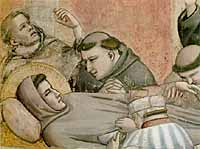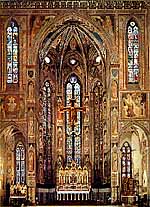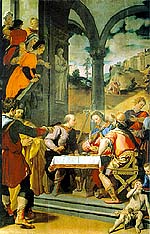
Giotto, Bardi Chapel
Excusez nous mais cette page n'est pas été encore traduite en Français
The walls of the chapels and the rest of the interior of the Basilica of Santa Croce were gradually transformed during the 14th century into a triumph of Gothic painting, such as had never been seen before (except in the Franciscan Basilica at Assisi). Frescoes, polyptyches and stained glass windows were created by the great artist Cimabue ( Velluti Chapel, with a few traces of frescoes), the even greater artist Giotto (Bardi and Peruzzi Chapels, between 1320-30 circa) and all his school: Maso di Banco (Bardi di Vernio Chapel, around 1340), Taddeo Gaddi (Baroncelli-Giugni Chapel, 1332-38 circa, and the Calderini-Riccardi Chapel, frescoes destroyed in the 17th century), and Bernardo Daddi (Pulci-Berardi Chapel, 1330 circa).

Agnolo
Gaddi, Main Chapel
Second generation artists from the school of Giotto also worked here, including Giovanni da Milano (Rinuccini Chapel, 1363-66 circa, inside the sacristy), Agnolo Gaddi (Maggiore or Alberti Chapel, 1380 circa, the Castellani Chapel, 1385 circa, and the Bardi Chapel in the lefthand transept, frescoes that have since been destroyed) and the Orcagna family: Andrea di Cione and his brothers covered the whole of the interior with several cycles of frescoes, including the beautiful Triumph of Death (1360 circa), of which only a few fragments remain today in the Museum of the Opera of Santa Croce.
In fact, between 1566-84, like many other churches in the city, the basilica was put through one of Giorgio Vasari's interventions of "modernization", which meant that he painted over and destroyed the frescoes in the three naves and applied a series of heavy classical style altars to the walls: fragments from the Triumph of Death (a popular subject after the plague epidemic in 1348) were only recently found behind one of these altars.

Santi di Tito, Supper at Emmaus
Vasari also knocked down the chancel partition which was often used during the Middle Ages to divide the naves (for the common people) from the chancel and the area of the apse (reserved for the clergy and city dignitaries). The smaller chapels and other altars that were attached to the partition were transferred in regular sequence along the minor naves and decorated with huge paintings by some of the finest Florentine artists of the 16th century: Vasari himself, Bronzino, Alessandro Allori, Cigoli, Empoli, Santi di Tito and others. The high altar was also subjected to Vasari's "improvements" and replaced by a huge carved and gilded wooden "machine", decorated with statues of saints and angels and an enormous baldachin. This overpowering invention was dismantled in 1869 but parts of it can still be seen in the Bardi Chapel in the transept.
To put a cap on Vasari's alterations, the Gothic painting suffered additional damage in the early decades of the 18th century, when other frescoes were destroyed, painted over or replaced. Even Giotto's frescoes were damaged or, as in the case of the decorations in the Tosinghi-Spinelli Chapel, completely lost, while the frescoes in the Bardi and Peruzzi Chapels, which had been whitewashed over, were not discovered again until the middle of the last century.
